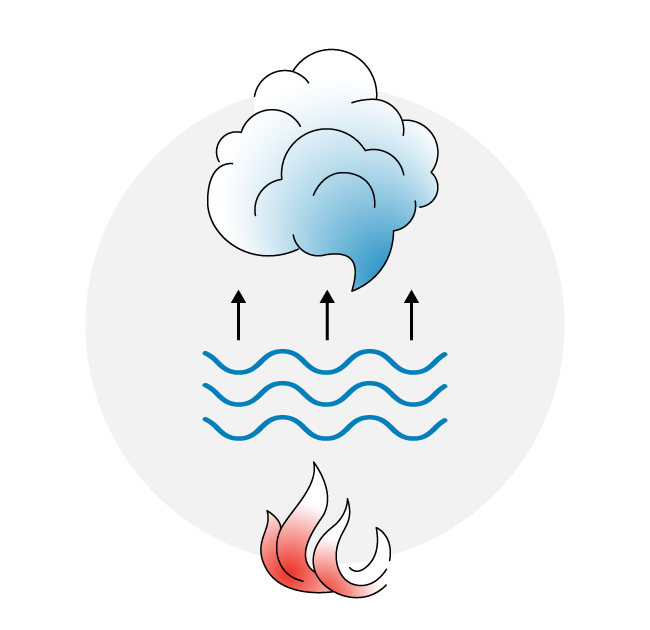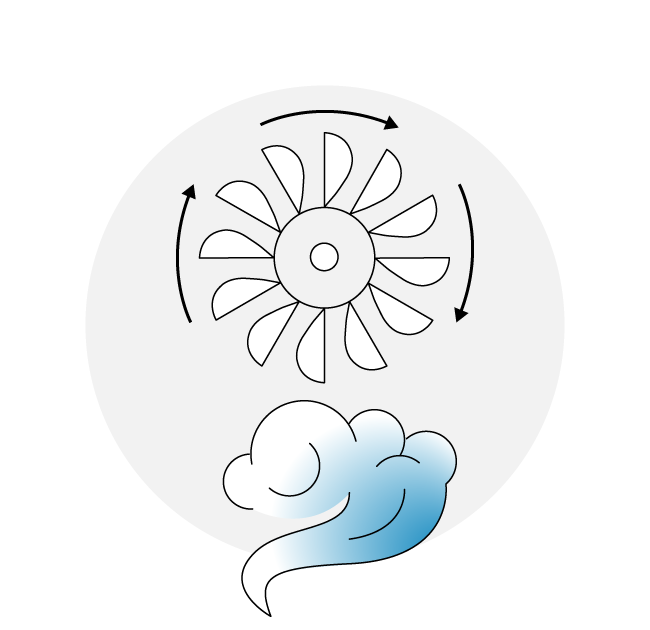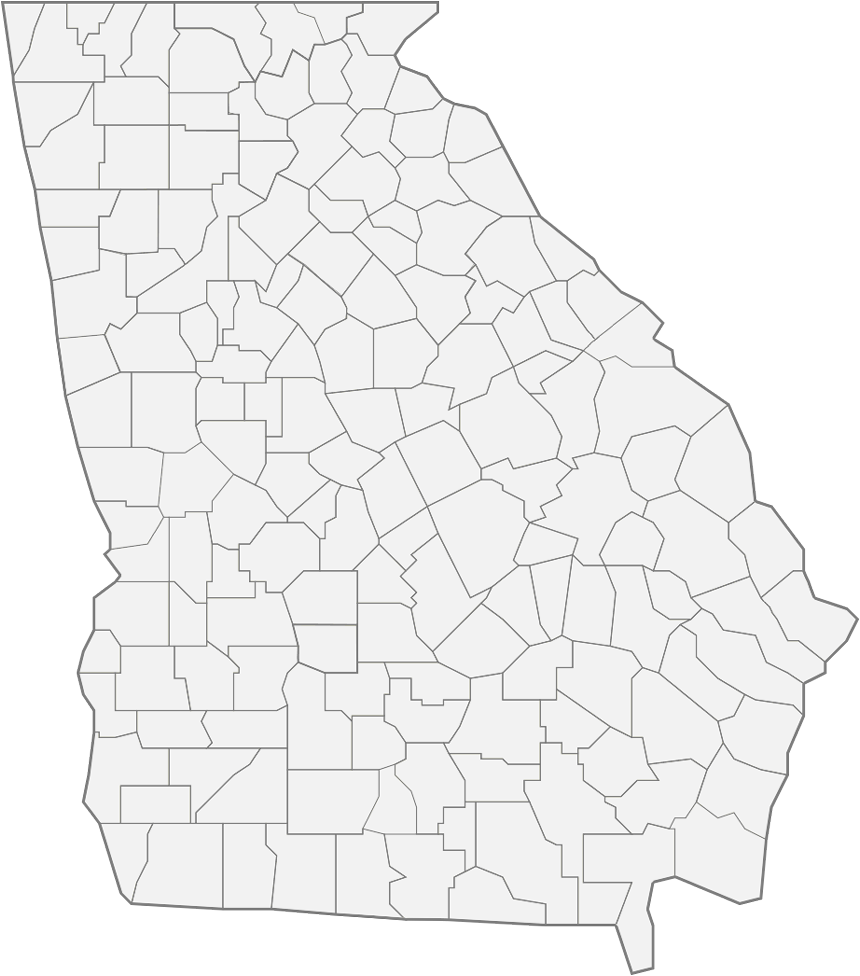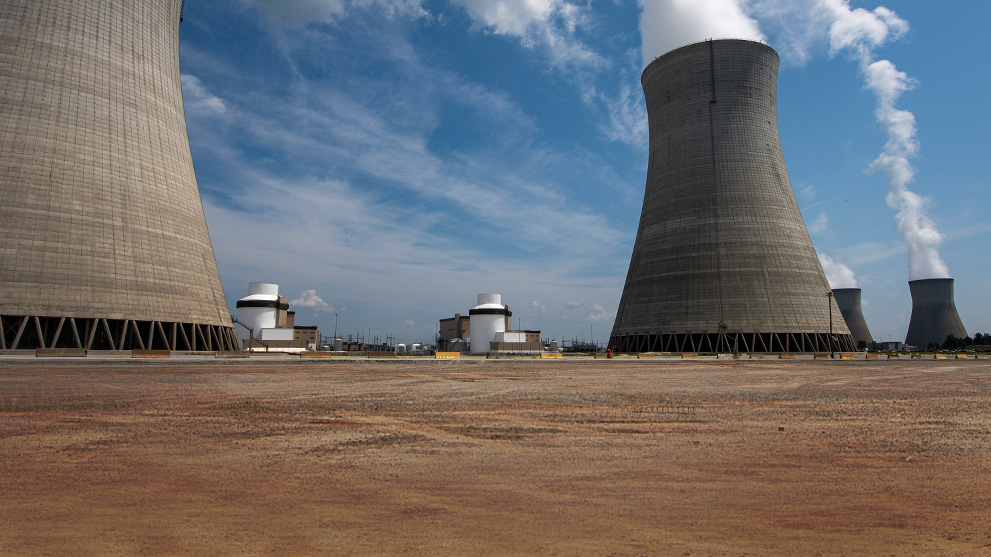Benefits of Nuclear
Emission-Free Reliable Energy
Nuclear power units are dispatchable and can generate carbon-free energy at full output 24/7 – more than twice as much as solar and wind resources.
Nuclear requires fewer maintenance outages than coal or gas, it's not subject to unpredictable weather or climate conditions, and nuclear fuel costs fluctuate less often than other fuel sources.
Plant Vogtle Unit 3's nuclear reactor
Fuel assembly being loaded into the Plant Vogtle Unit 3 reactor vessel
How Nuclear Works
The difference from fossil fuel plants is that a nuclear plant uses fission to generate the heat needed to transform the water into steam.

Atoms are split in process called fission inside the reactor core

The heat generated is used to heat up water into steam

The steam pushes the turbines

Generator is turned by the turbines generating electricity
Vogtle Units 3 & 4 Expansion
Plant Vogtle is now the largest generator of clean energy in the U.S.
Completed on April 29, 2024, Plant Vogtle Units 3 & 4 are the first newly constructed nuclear units to be built in the United States in more than 30 years, and will continue to provide clean, safe, reliable and affordable energy for millions of Georgians for next 60-80 years.
Our Nuclear Plants
Our two nuclear facilities, Hatch and Vogtle, provide about 20 percent of the electricity used in Georgia. Our plants are managed by Southern Nuclear, a sister company owned by Southern Company, which specializes in nuclear operations.
1. Plant Vogtle
Location:
Waynesboro, Georgia
Current total generating capacity:
~ 4,664 MW
Commercial operation:
Unit 1: June 1, 1987
Unit 2: May 20, 1989
Unit 3: July 31, 2023
Unit 4: April 29, 2024
2. Plant Hatch
Location:
Baxley, Georgia
Current total generating capacity:
~ 1,848 MW
Commercial operation:
Unit 1: December, 1975
Unit 2: September, 1979

Plant Vogtle
Location:
Waynesboro, Georgia
Current total generating capacity:
~ 4,664 MW
Commercial operation:
Unit 1: June 1, 1987
Unit 2: May 20, 1989
Unit 3: July 31, 2023
Unit 4: April 29, 2024
Plant Hatch
Location:
Baxley, Georgia
Current total generating capacity:
~ 1,848 MW
Commercial operation:
Unit 1: December, 1975
Unit 2: September, 1979
Frequently Asked Questions
What is nuclear fission?
Fission is the splitting of atoms into smaller parts. Some atoms, themselves tiny, split when they are struck by even smaller particles, called neutrons.
Like most U. S. nuclear power plants, the fuel used at Plant Hatch and Vogtle is manufactured using uranium enriched in Uranium-235 (U-235). Fission occurs when a uranium or plutonium atom absorbs a neutron and the atom splits. In the process, the atom produces additional neutrons (an average of 2.5 each fission), which go on to split more U-235 and Pu-239 atoms, which create more neutrons, and so on. The result is a chain reaction.
In a nuclear power plant, the chain reaction is controlled to keep it from releasing too much energy too fast. In this way, the chain reaction continues for a long time.
When a uranium atom is split, it releases a large amount of energy in the form of heat. This heat transfers to the water that is continuously flowing through the reactor, causing it to boil water and create steam. The pressure of the expanding steam turns a turbine that is connected to a generator.
Other than the heat source, a nuclear energy facility operates like any fossil fuel plant: 1) heat is created to boil water 2) to create steam 3) to turn the turbine 4) which spins the generator. The whirling magnetic field of the generator produces electricity.
What is the white cloud seen coming from Georgia's nuclear power plants?
The cloud coming from the cooling towers is simply water vapor or steam. The steam contains no radiation or other harmful emissions.
After the steam completes the electricity generation process, it enters a condenser where it is cooled back into water for reuse. Cooling water supplied from the cooling towers flows through pipes within the condenser.
This external cooling water never comes in physical contact with the steam. It is warmed in the condenser and returned to the cooling tower a warmer temperature than when it was removed. The excess heat is given up to the atmosphere as steam.
How is nuclear energy regulated in Georgia?
Nuclear power generation is one of the most highly-regulated industries in the country.
The Nuclear Regulatory Commission (NRC) is responsible for oversight of all nuclear plant operations, including licensing and regulating nuclear facilities and materials. These responsibilities include protecting public health and safety, protecting the environment, and protecting and safeguarding nuclear materials and nuclear power plants in the interest of national security.
NRC resident inspectors are on duty at each nuclear facility and have unrestricted access to the facility.
The Federal Emergency Management Agency (FEMA) is responsible for setting standards for off-site emergency preparedness programs and assessing their effectiveness. FEMA's Radiological Emergency Preparedness Program provides assistance to state and local governments in developing emergency plans for nuclear energy facilities, and coordinating response actions among the various agencies.
The Georgia Public Service Commission (PSC) oversees the operations at all Georgia Power generating plants in the state, no matter the fuel source, as they relate to costs and expenses allowed into rate base and charged to Georgia residents.
A multitude of additional agencies have oversight of specific activities at nuclear plants, for example the Environmental Protection Agency, the Department of Homeland Security, the Georgia Department of Natural Resources, among others.
What are the safety systems at Georgia nuclear plants?
All nuclear plants are designed with defense-in-depth safety systems. This means there are multiple systems, passive and active, in place to protect the reactor and the surrounding public.
Passive systems include physical barriers that would restrict the spread of contamination outside the primary systems. These include such barriers as the fuel's zirconium alloy cladding, the thickness of the reactor vessel and the concrete containment surrounding it.
Active systems are designed to ensure continuous core cooling and safe plant shutdown in the event of an accident. Some of these include the reactor protection system designed to automatically shut down the reactor if needed, multiple core cooling systems designed to replenish cooling water in the reactor if normal cooling water is lost, and containment isolation systems that can close all openings from the containment building to the outside.
Additional redundant systems are in place to detect and mitigate certain conditions that could pose a threat to the public.
What is uranium, and where does it come from?
Uranium is a radioactive element found in natural ores. Deposits of these ores are found in the western United States, Canada and Australia, among other locations.
Uranium recovery focuses on extracting (or mining) natural uranium ore from the Earth and concentrating (or milling) that ore. These recovery operations produce a product called "yellowcake" that is transformed into fuel for nuclear power reactors.
The next step is converting the yellowcake into pure uranium hexafluoride (UF6) gas suitable for use in enrichment operations. During this conversion, impurities are removed and the uranium is combined with fluorine to create the UF6 gas. The UF6 is then pressurized and cooled to a liquid. In its liquid state, it is drained into 14-ton cylinders where it solidifies after cooling for approximately five days. The UF6 cylinder in the solid form is then shipped to an enrichment plant.
Enriching uranium increases the proportion of uranium atoms that can be "split" by fission to release energy (in the form of heat) that can be used to produce electricity.
The fuel for nuclear reactors has to have a higher concentration of U235 than exists in natural uranium ore. This is because U235 is "fissionable," meaning that it starts a nuclear reaction and keeps it going. Normally, the amount of the U235 isotope is enriched from 0.7% of the uranium mass to about 5%.
How much radiation do nuclear energy facilities produce and how does that impact the public?
Federal regulations require a detailed assessment of environmental impacts associated with a nuclear energy facility before it can be licensed to operate.
Because an unintentional leak of radioactivity from nuclear plants is possible, the Nuclear Regulatory Commission (NRC) evaluates the potential impact of such leakage during the initial plant licensing process. The NRC conducted environmental assessments for all 104 operating reactors and is doing so for new reactors now in the licensing phase.
Electric power companies that operate nuclear energy facilities must begin radiological environmental monitoring at least three years before the plant begins operation, and must continue monitoring throughout the plant's lifetime.
Because radiation is naturally present in the environment, pre-operational monitoring establishes a baseline against which plant staff and the regulator can compare subsequent measurements.
The federal limit for annual radiation dose to the public from nuclear plant operations is 25 millirem. A REM (Roentgen Equivalent Man) is a unit of radiation exposure that indicates potential biological effect on human cells. A millirem is equal to one-thousandth of a rem. The average person receives about 300 millirems annually of naturally occurring background radiation from soil, rocks, consumer products, medical procedures, etc.
The average actual dose to the public from a nuclear power plant is about 2 millirem less than 10% of the regulatory limit.
Nuclear plants also are required to conduct radiological monitoring of air, water, land, food and produce grown near nuclear energy facilities.
How is used nuclear fuel stored in Georgia?
When used fuel is removed from a nuclear reactor, it is initially stored in steel-lined concrete vaults filled with water. The water cools the fuel while it decays and becomes less radioactive.
The federal government made a statutory and contractual commitment to begin accepting possession of all used fuel from nuclear power plant sites in 1998 for permanent storage in a central repository. Without that central repository, many nuclear plants have needed to supplement their storage capacity with above-ground, dry storage facilities.
As the used nuclear fuel cools, the fuel rods that have been stored longest in the spent fuel pools are moved to massive concrete and steel sealed containers that have been tested for safety and durability. Spent fuel rods can remain in these canisters for as long as necessary while the federal government reviews various long-term storage options.
Plant Hatch and Plant Vogtle currently use dry storage facilities.



